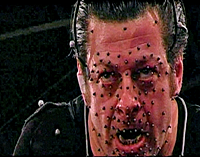The Passion of the Kong
How to Turn a Classic into a Masterpiece
An Appreciation by Barry M. Lamont
Motion Capture Animation
In this technique, hundreds of tiny points of light are placed on an actor's face and body; the motion of the points is digitally recorded during a separate take of the actor's performance; and a computer-generated character is mapped point-by-corresponding-point onto the actor. This allows the CG character to move like a real three-dimensional object; even if the scene is too imaginative to be enacted in its entirety, the actor's performance can be used as the basis for subsequent computer animation. Peter Jackson first used this technique extensively to create Gollum in Lord of the Rings, winning Weta a special Oscar (one of its ten), for Technical Achievement; Andy Serkis was the human actor whose performance was digitally transformed. When it came time to make King Kong, Jackson again asked Serkis to be the man behind the creature.
Serkis took the quest for realism very seriously. After initially spending time observing gorillas in zoos and sanctuaries, he realized that captivity distorted their behavior, and particularly their social interactions. He asked Peter Jackson to fly him to Rwanda, where he could observe mountain gorillas in the wild; when Jackson refused, saying it was too big a risk to take with the actor he needed for the title role, Serkis thanked him - then flew to Rwanda at his own expense and called Peter Jackson to let him know.
Mocap has a second benefit besides photorealism, an even more important one for Jackson's film: emotional realism. By basing a digital character on an actual actor, a CG character can give a fully-realized performance; by having the actor in the scene during filming, the other actors have someone to play off against. Many CG-heavy films place the actors against a green-screen or blue-screen, acting on a blank background while a stagehand holds a ball on a stick showing them where to look, and the director tells them to imagine what they are supposed to be seeing. Films made this way can still be fun - there were almost no actual sets or objects in Sky Captain and the World of Tomorrow - but it is hard to convey emotional interaction.
Kong thus ceased to be an amazing visual effect, and became a character in the drama to a much greater extent than was previously possible. This allowed Peter Jackson to tell a very different story than either of the two previous versions.
Serkis took the quest for realism very seriously. After initially spending time observing gorillas in zoos and sanctuaries, he realized that captivity distorted their behavior, and particularly their social interactions. He asked Peter Jackson to fly him to Rwanda, where he could observe mountain gorillas in the wild; when Jackson refused, saying it was too big a risk to take with the actor he needed for the title role, Serkis thanked him - then flew to Rwanda at his own expense and called Peter Jackson to let him know.
Mocap has a second benefit besides photorealism, an even more important one for Jackson's film: emotional realism. By basing a digital character on an actual actor, a CG character can give a fully-realized performance; by having the actor in the scene during filming, the other actors have someone to play off against. Many CG-heavy films place the actors against a green-screen or blue-screen, acting on a blank background while a stagehand holds a ball on a stick showing them where to look, and the director tells them to imagine what they are supposed to be seeing. Films made this way can still be fun - there were almost no actual sets or objects in Sky Captain and the World of Tomorrow - but it is hard to convey emotional interaction.
Kong thus ceased to be an amazing visual effect, and became a character in the drama to a much greater extent than was previously possible. This allowed Peter Jackson to tell a very different story than either of the two previous versions.
